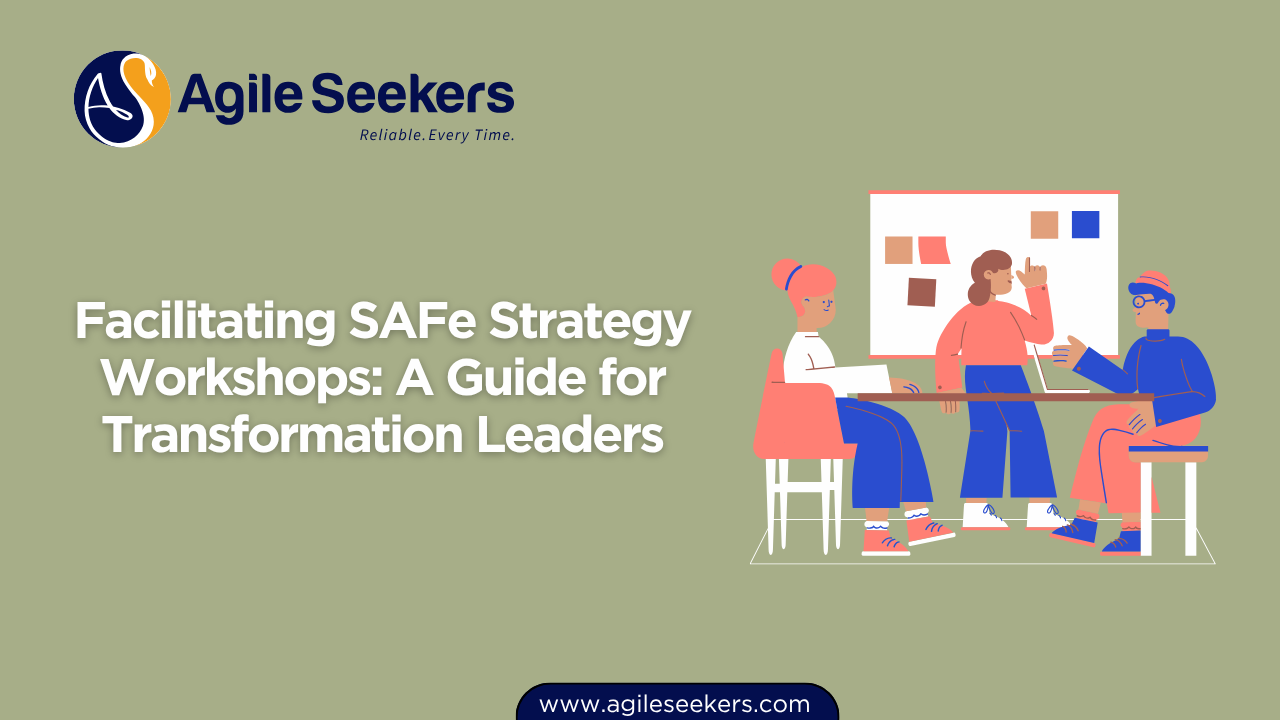Facilitating SAFe Strategy Workshops: A Guide for Transformation Leaders

Strategic alignment doesn’t happen by chance—it requires deliberate planning, thoughtful facilitation, and the ability to bring people together around a shared direction. That’s where SAFe® Strategy Workshops come into play. These workshops help leadership teams identify, shape, and align around a shared vision that drives enterprise agility.
For transformation leaders, facilitating SAFe strategy workshops is not just about following a template. It involves navigating complex organizational dynamics, enabling constructive dialogue, and ensuring outcomes turn into actionable plans. This post walks through how to effectively plan and facilitate these workshops—and how they connect to broader SAFe roles and capabilities.
Why Strategy Workshops Matter in a SAFe Transformation
In any SAFe implementation, alignment between strategy and execution is foundational. Organizations that skip structured strategic planning often suffer from misaligned teams, unclear priorities, and conflicting goals. A well-run strategy workshop helps:
-
Define a clear strategic intent
-
Align business and technology leadership
-
Identify key outcomes and value streams
-
Prioritize epics that deliver the most value
-
Prepare the enterprise for PI Planning and execution
These sessions are typically held before launching or re-aligning Agile Release Trains (ARTs) and should be repeated as part of a regular cadence, aligned with Portfolio or Value Stream planning.
Who Should Facilitate: The Role of the Transformation Leader
A transformation leader may be a SAFe Program Consultant (SPC), Release Train Engineer (RTE), or Lean Portfolio Management (LPM) stakeholder. Their job is to guide the room—ensuring clarity, flow, and value generation from the session.
If you’ve completed the Leading SAFe Certification, you likely understand how to create a shared vision and align Lean-Agile leadership. This foundation is essential when orchestrating strategic discussions across business and IT.
Preparing for a SAFe Strategy Workshop
Effective facilitation begins with solid preparation. Here's a checklist transformation leaders should consider:
1. Clarify the Workshop Goals
What needs to be achieved? Common goals include:
-
Establishing strategic themes
-
Mapping value streams
-
Clarifying the current state vs. desired future
-
Creating a Lean Budget Guardrail structure
2. Gather the Right People
Invite cross-functional leadership, including:
-
Portfolio owners
-
Epic owners
-
Value stream leaders
-
Product Managers and Product Owners
-
System Architects
If you’re working with SAFe Product Owner/Product Manager (POPM) certified professionals, their input will be vital when prioritizing value streams and capabilities.
3. Prepare Strategic Inputs
Ensure the following data points are ready:
-
Customer insights
-
Financials
-
Operational metrics
-
Existing OKRs or strategic goals
-
Market trends
This aligns with the concept of outcome-based planning described by Scaled Agile.
Running the Workshop: Step-by-Step Guide
Step 1: Set the Context
Begin by establishing why the strategy session is happening. Share enterprise goals, current pain points, and outcomes expected from the session. A SAFe Scrum Master or facilitator should ensure psychological safety and timeboxing for every discussion.
Step 2: Review Vision and Strategic Themes
This part defines where the business is heading. Focus on:
-
Customer-centric value
-
Emerging technologies
-
Competitive differentiators
-
Operational excellence
Use structured brainstorming, Lean Coffee, or voting techniques to drive consensus.
Step 3: Value Stream Identification or Review
Map how value flows across the organization. Use SAFe’s Value Stream Identification Workshop format and support the session with individuals certified in SAFe Release Train Engineer (RTE), as they understand value stream coordination deeply.
Step 4: Capability and Epic Discovery
Facilitate a discussion on the capabilities needed to deliver strategic outcomes. Introduce high-level epics and clarify which need further elaboration in the Portfolio Kanban.
Product Owners and Product Managers play a key role here. Teams with SAFe POPM certification are equipped to handle backlog shaping and MVP identification at this stage.
Step 5: Set Leading Indicators and OKRs
Every strategy needs a way to track progress. Use OKRs to define outcome-focused goals. Make sure these OKRs align with Portfolio and ART-level outcomes.
You can refer to the OKRs in SAFe whitepaper for practical examples on formulating effective metrics.
Facilitator Tips: Driving Engagement and Clarity
-
Use timeboxes to keep energy and decisions flowing
-
Visualize everything using canvases, sticky notes, or digital whiteboards
-
Park off-topic discussions and revisit later
-
Balance power dynamics—ensure everyone’s voice is heard
-
Summarize regularly—what’s decided, what’s pending
If you’re trained in the SAFe Advanced Scrum Master program, you'll be more comfortable managing facilitation in complex, cross-team settings.
After the Workshop: Turning Strategy into Execution
Facilitation doesn’t end when the meeting wraps up. As a transformation leader, you must ensure:
-
Workshop outcomes are documented and distributed
-
Portfolio Kanban is updated
-
Epics are handed over to Epic Owners for refinement
-
Value stream teams are aligned ahead of PI Planning
Follow-through is where most strategies fail. Build a cadence for inspecting and adapting strategic progress using Lean Portfolio Management syncs.
Key Outcomes to Track
-
Defined or updated strategic themes
-
Mapped value streams
-
A prioritized list of business epics
-
Clear OKRs or metrics tied to business value
-
Action plan for upcoming PI or ART launches
These deliverables ensure continuity from strategy to backlog and, eventually, to customer-delivered value.
Final Thoughts
Strategy workshops in SAFe aren’t just a formality—they are a practical space for organizations to reflect, prioritize, and align. For transformation leaders, mastering the art of facilitation is critical to keeping momentum and delivering outcomes that matter.
Whether you’re leading from a Leading SAFe perspective or coordinating with SAFe Scrum Masters and RTEs, strategic workshops are your opportunity to turn vision into movement.
By building the right environment, inviting the right voices, and guiding conversations toward meaningful decisions, you’ll not only enable SAFe success—you’ll enable transformation.
Also read - Running Effective SAFe Workshops to Align Business and Technology Leaders
Also see - Building a Shared Vision: How Cross-Functional Teams Align on SAFe Goals




















